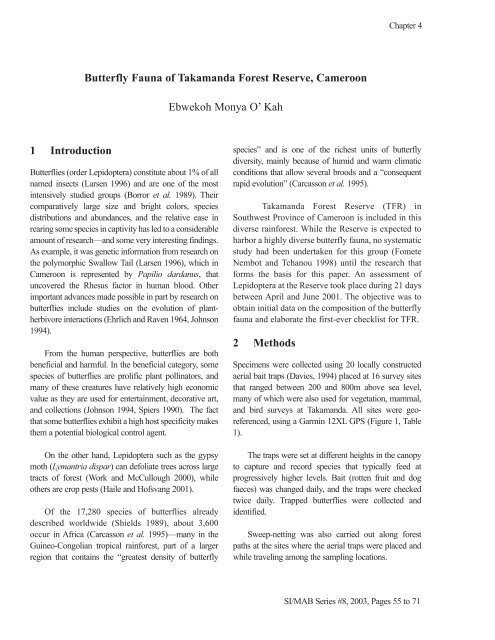Fisheries in the Southern Border Zone of Takamanda - Impact ...
Fisheries in the Southern Border Zone of Takamanda - Impact ...
Fisheries in the Southern Border Zone of Takamanda - Impact ...
Create successful ePaper yourself
Turn your PDF publications into a flip-book with our unique Google optimized e-Paper software.
1 Introduction<br />
Butterfly Fauna <strong>of</strong> <strong>Takamanda</strong> Forest Reserve, Cameroon<br />
Butterflies (order Lepidoptera) constitute about 1% <strong>of</strong> all<br />
named <strong>in</strong>sects (Larsen 1996) and are one <strong>of</strong> <strong>the</strong> most<br />
<strong>in</strong>tensively studied groups (Borror et al. 1989). Their<br />
comparatively large size and bright colors, species<br />
distributions and abundances, and <strong>the</strong> relative ease <strong>in</strong><br />
rear<strong>in</strong>g some species <strong>in</strong> captivity has led to a considerable<br />
amount <strong>of</strong> research—and some very <strong>in</strong>terest<strong>in</strong>g f<strong>in</strong>d<strong>in</strong>gs.<br />
As example, it was genetic <strong>in</strong>formation from research on<br />
<strong>the</strong> polymorphic Swallow Tail (Larsen 1996), which <strong>in</strong><br />
Cameroon is represented by Papilio dardanus, that<br />
uncovered <strong>the</strong> Rhesus factor <strong>in</strong> human blood. O<strong>the</strong>r<br />
important advances made possible <strong>in</strong> part by research on<br />
butterflies <strong>in</strong>clude studies on <strong>the</strong> evolution <strong>of</strong> plan<strong>the</strong>rbivore<br />
<strong>in</strong>teractions (Ehrlich and Raven 1964, Johnson<br />
1994).<br />
From <strong>the</strong> human perspective, butterflies are both<br />
beneficial and harmful. In <strong>the</strong> beneficial category, some<br />
species <strong>of</strong> butterflies are prolific plant poll<strong>in</strong>ators, and<br />
many <strong>of</strong> <strong>the</strong>se creatures have relatively high economic<br />
value as <strong>the</strong>y are used for enterta<strong>in</strong>ment, decorative art,<br />
and collections (Johnson 1994, Spiers 1990). The fact<br />
that some butterflies exhibit a high host specificity makes<br />
<strong>the</strong>m a potential biological control agent.<br />
On <strong>the</strong> o<strong>the</strong>r hand, Lepidoptera such as <strong>the</strong> gypsy<br />
moth (Lymantria dispar) can defoliate trees across large<br />
tracts <strong>of</strong> forest (Work and McCullough 2000), while<br />
o<strong>the</strong>rs are crop pests (Haile and H<strong>of</strong>svang 2001).<br />
Of <strong>the</strong> 17,280 species <strong>of</strong> butterflies already<br />
described worldwide (Shields 1989), about 3,600<br />
occur <strong>in</strong> Africa (Carcasson et al. 1995)—many <strong>in</strong> <strong>the</strong><br />
Gu<strong>in</strong>eo-Congolian tropical ra<strong>in</strong>forest, part <strong>of</strong> a larger<br />
region that conta<strong>in</strong>s <strong>the</strong> “greatest density <strong>of</strong> butterfly<br />
Ebwekoh Monya O’ Kah<br />
Chapter 4<br />
species” and is one <strong>of</strong> <strong>the</strong> richest units <strong>of</strong> butterfly<br />
diversity, ma<strong>in</strong>ly because <strong>of</strong> humid and warm climatic<br />
conditions that allow several broods and a “consequent<br />
rapid evolution” (Carcasson et al. 1995).<br />
<strong>Takamanda</strong> Forest Reserve (TFR) <strong>in</strong><br />
Southwest Prov<strong>in</strong>ce <strong>of</strong> Cameroon is <strong>in</strong>cluded <strong>in</strong> this<br />
diverse ra<strong>in</strong>forest. While <strong>the</strong> Reserve is expected to<br />
harbor a highly diverse butterfly fauna, no systematic<br />
study had been undertaken for this group (Fomete<br />
Nembot and Tchanou 1998) until <strong>the</strong> research that<br />
forms <strong>the</strong> basis for this paper. An assessment <strong>of</strong><br />
Lepidoptera at <strong>the</strong> Reserve took place dur<strong>in</strong>g 21 days<br />
between April and June 2001. The objective was to<br />
obta<strong>in</strong> <strong>in</strong>itial data on <strong>the</strong> composition <strong>of</strong> <strong>the</strong> butterfly<br />
fauna and elaborate <strong>the</strong> first-ever checklist for TFR.<br />
2 Methods<br />
Specimens were collected us<strong>in</strong>g 20 locally constructed<br />
aerial bait traps (Davies, 1994) placed at 16 survey sites<br />
that ranged between 200 and 800m above sea level,<br />
many <strong>of</strong> which were also used for vegetation, mammal,<br />
and bird surveys at <strong>Takamanda</strong>. All sites were georeferenced,<br />
us<strong>in</strong>g a Garm<strong>in</strong> 12XL GPS (Figure 1, Table<br />
1).<br />
The traps were set at different heights <strong>in</strong> <strong>the</strong> canopy<br />
to capture and record species that typically feed at<br />
progressively higher levels. Bait (rotten fruit and dog<br />
faeces) was changed daily, and <strong>the</strong> traps were checked<br />
twice daily. Trapped butterflies were collected and<br />
identified.<br />
Sweep-nett<strong>in</strong>g was also carried out along forest<br />
paths at <strong>the</strong> sites where <strong>the</strong> aerial traps were placed and<br />
while travel<strong>in</strong>g among <strong>the</strong> sampl<strong>in</strong>g locations.<br />
SI/MAB Series #8, 2003, Pages 55 to 71

















